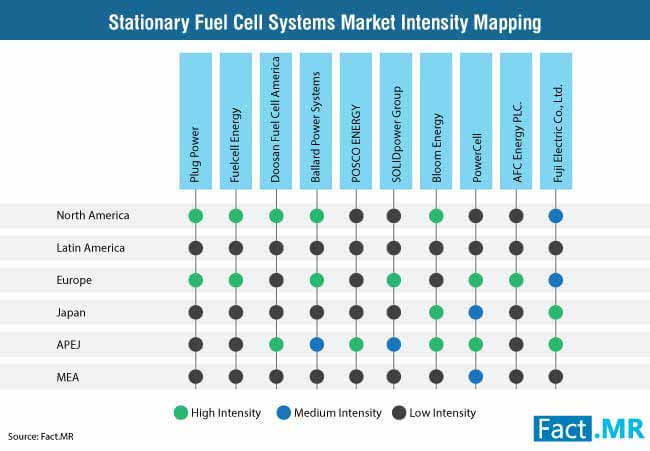
The stationary fuel cell systems market will record a hefty 17.9% y-o-y over 2018 to reach over US$ 2,159 million by the end of 2019, reveals a recent market study published by Fact.MR.
The study offers a holistic assessment on various market dynamics and macro and micro-economic factors that are influencing adoption of stationary fuel cell systems in various industrial verticals.
Request for Sample https://www.factmr.com/connectus/sample?flag=S&rep_id=2456
Combined heat and power (CHP) or cogeneration is one of the most common applications of stationary fuel cell systems, which accounted for the largest revenue share of over 45% in 2018, according to the Fact.MR study.
“CHP is one of the most commonly used stationary power generation systems installed to generate electricity as well as heat. In the modern days, fuel cells are widely used in the manufacturing of CHP, which acts of the leading driving force for the growth of the stationary fuel cell systems market,” said a lead analyst at Fact.MR.
“When stationary fuel cell systems are incorporated in CHP, it offers extraordinary benefits in terms of efficiency, sustainability, reliability, and cost-efficiency. As compared to conventional power generation methods, which commonly involve combustion engines, CHP is considered environment-friendly and highly efficient, which is boosting adoption of stationary fuel cell systems among CHP manufacturers across the world.”
Apart from the efficiency- and sustainability-related benefits of incorporating stationary fuel cell systems in CHP, subsidies and incentives offered by governing bodies in various regions is providing a fillip to the global demand for stationary fuel cell systems in the CHP industrial sector.
For example, the U.S. Environmental Protection Agency (EPA) removed policy barriers for CHP projects in the region, and it is establishing partnerships with CHP stakeholders to provide them with necessary resources, tools, and policy information.
The positive growth environments for CHP applications in various regions is expected to generate most lucrative opportunities for players in the stationary fuel cell systems market. Consumers’ awareness and favorable regularity framework for CHP is expected to make it the most popular application of stationary fuel cell systems in the upcoming years.
APEJ Region will Outperform Developed Regions to Generate Maximum Sales Opportunities for Stationary Fuel Cell Systems
According to the Fact.MR study, the APEJ region has witnessed the highest growth rate in the past few years, and accounted for over one third revenue share in the stationary fuel cell systems market in 2018.
Request for Methodology https://www.factmr.com/connectus/sample?flag=RM&rep_id=2456
While developed countries have continually created a positive growth environment for stationary fuel cell systems, the Asia Pacific region excluding Japan (APEJ) has outpaced other regions to attract maximum investments from stakeholders in the stationary fuel cell systems market.
Recent developments and technological transformations in the automotive industry in the APEJ region have triggered the use of stationary fuel cell systems in modern vehicles. Increasing environmental concerns and governmental strategies are driving leading automakers in the region to boost the use of stationary fuel cell systems in electric vehicles for stationary power generation in automobiles.
Recently, Korean Prime Minister Lee Nak-yon proposed to make use of world-class technology to use hydrogen fuel cell in police buses, in order to engage more eco-friendly vehicles in the country.
As a result, the government projects a potential rise in domestic demand for emission-free vehicles, which will ultimately generate lucrative opportunities for manufacturers in the stationary fuel cell systems market.
In addition, Hydrogen Utility (H2U), an Australian infrastructure company, has proposed to establish a $117.5 million, hydrogen-fuelled electrolyzer plant in South Australia. The company received a $7.5 million loan and $4.7 million grant from the state renewables fund, which signifies favorable governing policies that are a positive growth environment for stationary fuel cell systems market players in the Asia Pacific region.
For in-depth competitive analysis, buy now https://www.factmr.com/checkout/2456/S
The Fact.MR study opines that the stationary fuel cell systems market in the APEJ region will continue to lead the rally in the upcoming years. The study provides optimistic growth prospects of the stationary fuel cell systems market for the assessment period of 2018-2027.
According to the Fact.MR study, the stationary fuel cell systems market will envisage a staggering 19.8% value CAGR during the forecast period 2018-2027.
About Fact.MR
Market research and consulting agency with a difference! That’s why 80% of Fortune 1,000 companies trust us for making their most critical decisions. While our experienced consultants employ the latest technologies to extract hard-to-find insights, we believe our USP is the trust clients have on our expertise. Spanning a wide range – from automotive & industry 4.0 to healthcare & retail, our coverage is expansive, but we ensure even the most niche categories are analyzed. Our sales offices in United States and Dublin, Ireland. Headquarter based in Dubai, UAE. Reach out to us with your goals, and we’ll be an able research partner.
Contact:
US Sales Office:
11140 Rockville Pike
Suite 400
Rockville, MD 20852
United States
Tel: +1 (628) 251-1583
E: sales@factmr.com
Corporate Headquarter:
Unit No: AU-01-H Gold Tower (AU),
Plot No: JLT-PH1-I3A,
Jumeirah Lakes Towers,
Dubai, United Arab Emirates





